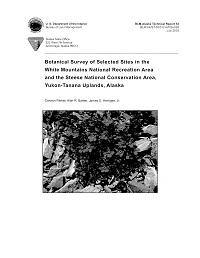Botanical Survey of Selected Sites in the White Mountains National Recreation Area and the Steese National Conservation Area, Yukon-Tanana Uplands, Alaska

The Bureau of Land Management is mandated to preserve biodiversity and prevent extinction of rare species on public lands. Baseline resource inventories focusing on rare and sensitive taxa improve our knowledge of their abundance and distribution and are essential for making sound management decisions. permanently curated specimens document the occurrence of all plants and are available for review by botanists. Electronically databased collection information can be readily shared with relevant agencies and researchers. These steps become invaluable when the areas of concern are remote and not easily revisited.
The Yukon-Tanana Uplands in interior Alaska are within the glacial refugium Beringia, a large region stretching from the MacKenzie River in Canada to the Lena River in Siberia. This region was connected by the exposed continental shelf during the Quaternary full glacials, yet remained free of continental ice sheets. The uplands are known to be rich in plants endemic (restricted in distribution) to Beringia and several are currently listed as rare to critically imperiled at the state and global level by the Alaska Natural Heritage Program (AKNHP). However, much of the area is remote and poorly known botanically.
The White Mountains National Recreation Area and the Steese National Conservation Area are managed by BLM-Alaska's Northern Field Office. Together they include a large portion of the Uplands landscape. Twelve sites within these BLM management units that were known or suspected to support rare plants were surveyed by botanists during the summers 1994-1996. Most sites were in the alpine and subalpine zones, where habitats known to support rare and endemic plants are most common. At each site the vegetation was described and all vascular plants observes were listed. At the first two sites all species encountered were collected as herbarium specimens. Collecting at the remaining sites was limited to taxa that had not been found previously during the survey, were difficult to identify in the field, or that were found in uncommon habitats or plant assemblages. Collections were made and additional habitat information was noted whenever populations of potentially sensitive plants were located.
The resulting inventory documents the vascular flora of the alpine and subalpine zones of the Yukon-Tanana Uplands with 990 plant specimens representing 382 taxa. Sixteen plants listed as critically imperiled (S1) to rare (S3) by the AKNHP were found and their known distribution and habitat preferences within the Uplands are summarized. Three species, Drebe densifolia, Poa porsi/dii, and Montia bostockii, were found to be more common than previously thought in at least a portion of the area surveyed. Six species were recorded as new to the Yukon-Tanana Uplands flora, including Oraba ruaxes, ranked imperiled (S2). Minor to moderate range extensions within the Uplands are documented for nine additional plants, including Festuca /enensis, ranked imperiled to rare (S2S3), and Trisetum sibiricum spp. liiorelis, ranked imperiled (S2). Our knowledge of the sensitive vascular plant species in the Uplands has been greatly enhanced as a result of this survey.
Recommendations for management addressing the potential sources of impacts on known populations of rare plants are offered, along with suggestions for future inventories.
